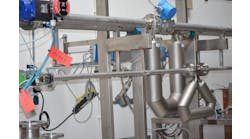In 1977, Jim Smith invented the Coriolis meter and formed Micro Motion to bring the world’s first direct mass meter to market. Since that time, the organization has engineered assurance into a broad range of industry-standard Coriolis solutions that offer reliable, accurate and long-lasting flow and density measurements that have proven vital to the success of its global customer base.
With the 45th anniversary of that technology breakthrough approaching, Control Editor-in-Chief Keith Larson caught up with Andy Dudiak, president, Flow Measurement, Emerson, to discuss the organization’s continuing legacy of engineering expertise and customer-driven innovation.
Q: What was it that really differentiated the first Coriolis mass meter from other measurement technologies?
A: The Coriolis meter was the first practical device to measure mass flow of liquids directly—it was completely unique at the time. All the other flow technologies available measure volumetric flow or velocity. You simply don’t have the same understanding of what’s going through the pipe.
Q: What industries first recognized the value that this new technology could bring to deliver?
A: Direct mass flow measurement was of specific interest to chemical companies because the stoichiometric relationships among reactants are based on mass. The first Micro Motion meters were sold into the chemical industry. Other early adopters included life sciences and food and beverage companies, which appreciated the extremely high accuracy over broad ranges obtainable with Coriolis technology. This meant that multiple ingredients and products could be batched through a single meter without recalibrating for different ranges. Also, the non-intrusive nature of the meter was a good fit for sanitary, clean-in-place applications.
The first oil and gas applications followed in Asia and Europe where they were accustomed to measuring hydrocarbons by mass rather than volume. But in the US, Coriolis technology didn’t really start to take off in that sector until the 1990s, when the standards bodies started to recognize that a Coriolis meter reading could readily be converted into a highly accurate volumetric reading. We started to provide a volumetric output option for our meters, and applications grew from there.
Q: Micro Motion became part of the Emerson family back in 1984. What did that milestone represent for the organization?
A: First, becoming part of the larger Emerson organization meant an increase in available resources. Most notably, we were able to take the Micro Motion brand global. We saw a steady increase in product development investment that further kept our meters the leader of the pack. Also, that was when Gene Perkins came in as new president, and helped us transition from an entrepreneurial, technology-based company to one with more structured processes—including an adamant focus on the customer, on quality and on continuous improvement.
On top of that, Emerson brought in a very thorough, thoughtful process around planning for the future of the business. I give a lot of credit to Jim Smith from a technology standpoint in the company’s early days then Gene Perkins, who helped us really grow from there. In the years since, we’ve worked closely with Emerson’s overall Automation Solutions business—from control systems to software and valves—and that alignment has led to continued growth.
Q: What technical innovation milestones have been key to the organization’s continued success over the years?
A: From a technology perspective, the launch of the world’s first dual-tube, D Series meter in 1983 eliminated a lot of the installation constraints of the earlier meters, which had to be stabilized by concrete anchors. With the D meter, the two tubes were able to reference each other, effectively cancelling out environmental effects such as vibrations from nearby equipment. This was a huge step forward in terms of installation flexibility.
The development of Smart Meter Verification in 2010 allowed customers to verify that their meters were working correctly without having to remove them from service. This was critical for increasing process uptime and satisfying calibration requirements around custody transfer applications. The release of the ELITE Series in 1992 leveraged advanced sensor and digital signal processing technology to set what has remained the benchmark for Coriolis meter performance, and in 2015 the release of the 5700 transmitter brought a new level of diagnostic capabilities to bear. Finally, as digital capabilities advanced, we pioneered Advance Phase Measurement, which allows us to measure both gas flows and the composition of multiphase mixtures. This capability continues to open new opportunities.
Q: What sorts of applications do you see as the next frontier?
A: We’re working to make Coriolis technology a better fit outside its strongholds of the chemical and oil and gas markets. The food and beverage and life science industries are of interest, and our latest 1600 transmitter includes a compact, integral housing, Power-over-Ethernet connectivity and other features of importance to these industries. Sustainability is an important target area as well, and in addition to compressed and liquified natural gas applications, we’ve applied our refinery experience with high pressure hydrogen to create dispensing solutions for the emerging, hydrogen-powered vehicle marketplace.
In the years to come, you can be sure our new offerings will continue to be engineered for assurance as well as easy to use and fit-to-purpose for our customers’ challenges.
Latest from Flow

Leaders relevant to this article:



